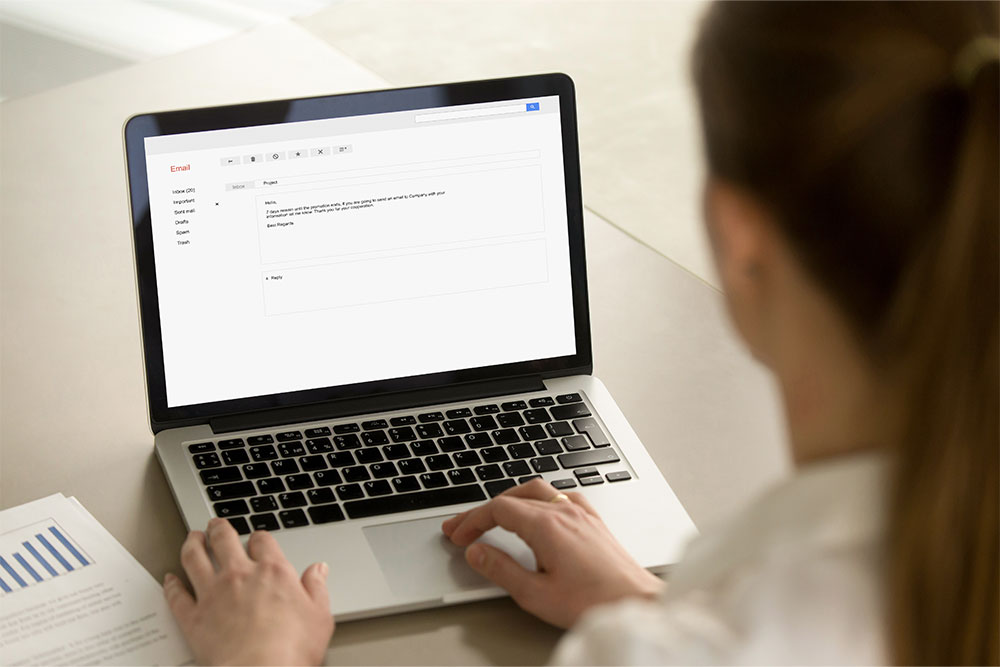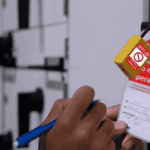
Most people recognise that communication is one of the most valuable skills you can have in the workplace.
It’s why so many of us slap communication skills onto our CVs without a second thought. (It’s not like you need a certificate to prove it anyway.)
But the gap between being able to communicate and being able to communicate well is bigger than most people realise. And just like any other skill, it takes effort to improve.
The first step is to learn about the types of communication, when to use them and how to use them well. Because just writing communication under the ‘Skills’ section of your CV doesn’t make it accurate.
4 Types of Communication
Here are the four types of communication, along with their ideal uses and strategies to do them effectively
1. Verbal Communication
The first of the four recognised types of communication is verbal. Being able to express yourself verbally is one of the top communication skills you can have, with the ability to use the spoken word effectively at the heart of many successful workplace interactions.
Talking face-to-face is maybe the best way to make yourself understood. You can use intonation to add meaning to your words, respond immediately to questions or comments and quickly rephrase or expand on something if it seems you’ve been misunderstood. No wonder so many communication issues can be solved with a quick chat.
The advantages of verbal communication extend to telephone conversations, remote meetings or video calls. However, these can sometimes feel stilted compared to in-person communication. This awkwardness can come from the lack of nonverbal cues you can give and receive through a video window or phone. However, speaking confidently–and listening effectively – is usually enough to overcome these limitations.
When to Use It
The best time to show your verbal communication skills is in group settings, where you must get your point across. Speaking to others gives you more control over how your words are interpreted and lets you react in the moment. Being able to talk capably in front of others in a meeting or presentation also projects an air of confidence, which gives your words more authority and can impress your co-workers.
Communication Skills Training
Our Communication Skills Training courses provide employers, managers and their employees with the fundamental aspects of effective communication for the success of businesses, organisations and individuals. It helps employers build constructive relationships with their workforce.
How to Get Better
The quality of your verbal communication is decided by four key factors:
- Word choice
- Structure (at both the sentence level and across your whole spoken piece)
- Clarity
- Intonation (pitch, tone and cadence)
How to Improve
To improve, you have to consider these aspects when you’re talking. Your word choice and structure will usually be a product of planning. However, we obviously don’t always know when we will have to verbally communicate or have the opportunity to plan our words. So, it helps to work on general speech skills. You can start by:
- Practising your speaking voice – Take the time to rehearse certain words you know trip you up. If you can overcome the embarrassment, it’s best to do this in front of the mirror. You can also work on your projection and tone, making sure your voice comes across clearly and confidently.
- Avoid filler words – Filler words (so, like, well) or noises (um, ah, ugh) are helpful when speaking as they give us a moment to think and choose our words mid-speech, which is essential (see above). But, excessive use of these fillers, particularly in presentations, can make you seem nervous or inexperienced. Be mindful of the particular filler words you tend to use and practise removing them from your speech patterns. You’ll need to regularly rehearse this to make any long-term impact.
- Read Books – You can choose your words more carefully and quickly if you’ve got a decent vocabulary. Reading (or listening to audiobooks) is the best way to build it. And you don’t need to read books about your particular industry or career. Fiction books work just as well, so read whatever takes your fancy as long as you do so regularly.
- Actively Listen – One point often overlooked when thinking about verbal communication skills is the ability to actively listen. What the other person says in a conversation is just as crucial as your contributions. Actively listening helps you understand your conversation partners, cues you to respond correctly and encourages productive communication. You can read more about listening skills here.

2. Nonverbal Communication
Nonverbal communication makes a critical difference to your in-person interactions (and when you decide to turn your camera on during remote meetings). It is one of the most important types of communication that supports your verbal communication efforts and ensures you’re coming across well when interacting with others.
When to Use It
Whenever you’re speaking face-to-face or in person. You can use your facial expression, posture and hands to reinforce your points. Eye contact is also essential to project confidence and connect with your audience.
How to Get Better
Think about what your face and body are communicating as you speak. But don’t go overboard. Your expression and body language should always come across as natural. Here are a few quick tips you can use:
- Smile (especially when greeting someone)
- Maintain a healthy amount of eye contact
- Keep an open posture (no folded arms) to encourage others to respond
- Square your shoulders and stand tall to project confidence
- Keep your feet pointed towards someone when they’re speaking (feet turned away is a tell-tale sign you’re not invested in the conversation)
Nonverbal communication reassures others that you’re confident, focused on the conversation and open to their input.

3. Written Communication
Arguably, it is the second most crucial method of communication after the spoken word. You’ll be hard-pressed to find a workplace you can excel in without the ability to write well.
When to Use It
Whenever you need a written record of something. Whether you’re writing instructions for others or asking for clarity on a project, a written document you can refer to multiple times is helpful. Using written forms of communication can also be useful when you need time to craft your message. And, of course, we all use email most days.
How to Get Better
Follow these tips:
- Keep it simple – The economy of language helps clarity
- Avoid jokes or sarcasm in your emails or messages – The written word isn’t great at communicating nuance or tone
- Keep a ‘swipe file’ – Keep a record of any text you find compelling, helping shape your own written communications
- Check before you send – Always proofread important docs before you share them with anyone; bonus points if you get a colleague to check them as well
- Use AI with caution – AI writing tools can help when you don’t know precisely what you want to say, but you can’t trust that what AI says is accurate or relevant

4. Visual Communication
Visual communication covers pictures, graphs and other graphic elements, making it easier for audiences to understand you. Images are also great at conveying emotions or concepts. Using symbols and colours can help highlight key points or make information easier to follow.
When to Use It
Similar to non-verbal cues, visual communication techniques should support your spoken or written words, particularly during presentations. Visual elements engage audiences and help convey information quickly.

How to Get Better
Effective visual communication reflects effective written communication; you should keep things simple. Think about these points when deciding on any visual elements in your communications:
- Use solid and straightforward images – Busy or cluttered images are distracting and make it harder to digest information
- Think about meaning – Consider how pictures might be interpreted by others; not everyone will take away the same meaning
- Clarity is vital – Only use images with sufficient resolution, colour and scale to ensure your audience can actually recognise what you’re trying to show them.
- Use icons and colours – Icons, symbols and colours are all effective at guiding your audience’s eyes to what you want to highlight, but remember to use them sparingly, or you might end up overwhelming viewers.
Common Barriers to Effective Communication
Even the best communicators are misunderstood occasionally, and audiences won’t always follow what you’re saying.
Here are some common communication barriers to keep in mind:
- Lack of clarity: If a message is vague, overly complex or filled with jargon, the receiver may misunderstand or ignore it.
- Poor listening skills: Communication is a two-way process. If someone isn’t actively listening, key information will be missed or misinterpreted.
- Nonverbal miscommunication: Body language, facial expressions or tone can contradict spoken words, leading to confusion.
- Emotional barriers: Personal emotions like stress, anger or frustration can affect how a message is delivered or received.
- Cultural and language differences: Differences in language, cultural norms or communication styles can lead to misunderstandings.
- Information overload: Too much information at once can overwhelm the receiver, making it hard to catch and retain key points.
Common Tips for All Types of Communication
However you’re communicating, certain principles will always help you do it more effectively. Here are some universal tips that apply across all four types of communication:
1. Know Your Audience
Your approach should be appropriate for not just the setting but also the listeners. Tailor your message to their knowledge, interests and expectations. A casual chat with a colleague should sound different to a formal presentation for company executives.
2. Be Precise and Concise
Use precise language. In general, avoid jargon, filler words, and overly complex sentences. Whether speaking, writing or presenting, keep your message straightforward and easy to grasp.
3. Engage and Adapt
Good communicators pay attention to their audience. Monitor their nonverbal as well as verbal reactions and adapt accordingly. Adjustments to your manner of communication can help the message be received as intended.
4. Practice Active Listening
Active listening is essential to effective communication. Focus on not just the speaker’s words but also their tone and body language to better understand and empathise with their point of view. Understanding how your conversation partner feels will help you respond more thoughtfully.
5. Be Mindful of Tone and Delivery
Your tone (both spoken and written) can drastically affect how the message is received. A poorly worded email might come across as rude, while a monotone speech can bore listeners. Pay attention to your delivery to ensure your message has the intended impact.
6. Stay Respectful and Professional
It’s always safer to be professional and respectful than being bold or overfriendly, especially in formal settings. Polite communication helps to keep interactions and relationships positive.
How You Can Improve All Your Communication Skills
After reading this blog, you should hopefully have a few ideas of what you can do to improve your communication skills. But mastery takes consistent effort and practise. A smart next step is to invest in some formal communication training.
Our online Communication Skills Training will help you become a better communicator. The course covers different methods of communication to help you develop all types of communication. You’ll learn how to actively listen, manage nonverbal cues and recognise common barriers to effective communication, helping you deliver clear, meaningful messages in the workplace. You’ll also get a training certificate – to prove your ability to communicate the next time someone questions the skills you mention on your CV.





















